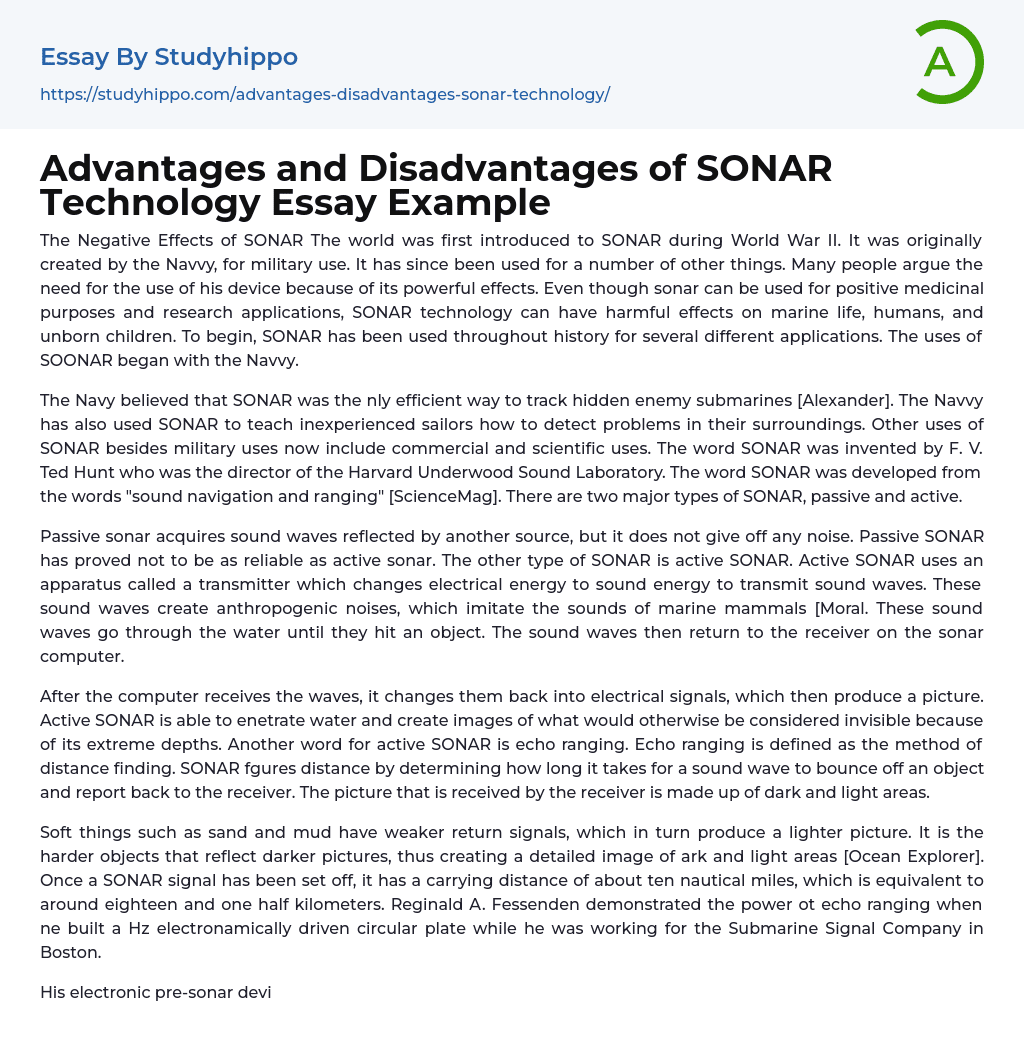

Advantages and Disadvantages of SONAR Technology Essay Example
The Negative Effects of SONAR The world was first introduced to SONAR during World War II. It was originally created by the Navvy, for military use. It has since been used for a number of other things. Many people argue the need for the use of his device because of its powerful effects. Even though sonar can be used for positive medicinal purposes and research applications, SONAR technology can have harmful effects on marine life, humans, and unborn children. To begin, SONAR has been used throughout history for several different applications. The uses of SOONAR began with the Navvy.
The Navy believed that SONAR was the nly efficient way to track hidden enemy submarines [Alexander]. The Navvy has also used SONAR to teach inexperienced sailors how to detect problems in their surroundings. Other uses of SONA
...R besides military uses now include commercial and scientific uses. The word SONAR was invented by F. V. Ted Hunt who was the director of the Harvard Underwood Sound Laboratory. The word SONAR was developed from the words "sound navigation and ranging" [ScienceMag]. There are two major types of SONAR, passive and active.
Passive sonar acquires sound waves reflected by another source, but it does not give off any noise. Passive SONAR has proved not to be as reliable as active sonar. The other type of SONAR is active SONAR. Active SONAR uses an apparatus called a transmitter which changes electrical energy to sound energy to transmit sound waves. These sound waves create anthropogenic noises, which imitate the sounds of marine mammals [Moral. These sound waves go through the water until they hit an object. The sound waves the
return to the receiver on the sonar computer.
After the computer receives the waves, it changes them back into electrical signals, which then produce a picture. Active SONAR is able to enetrate water and create images of what would otherwise be considered invisible because of its extreme depths. Another word for active SONAR is echo ranging. Echo ranging is defined as the method of distance finding. SONAR fgures distance by determining how long it takes for a sound wave to bounce off an object and report back to the receiver. The picture that is received by the receiver is made up of dark and light areas.
Soft things such as sand and mud have weaker return signals, which in turn produce a lighter picture. It is the harder objects that reflect darker pictures, thus creating a detailed image of ark and light areas [Ocean Explorer]. Once a SONAR signal has been set off, it has a carrying distance of about ten nautical miles, which is equivalent to around eighteen and one half kilometers. Reginald A. Fessenden demonstrated the power ot echo ranging when ne built a Hz electronamically driven circular plate while he was working for the Submarine Signal Company in Boston.
His electronic pre-sonar device detected an iceberg nearly three and a half kilometers off the coast of Newfoundland, Canada [D'Amico]. By 1933, the U. S Naval Research Laboratory installed echo ranging devices on eight estroyers. Soon people began to categorize the word SONAR with submarines and other underwater objects [The World Book Encyclopedia]. That was Just the beginning of the development of a revolutionary detection device. Both echo ranging devices and SONAR are
used today in oceans all over the world.
Controversy has arisen over the possibility of its harmful effects. Although revolutionary scientific breakthroughs have occurred with the advancements in technology such as SONAR and echo ranging devices, there have been recorded negative effects on animal marine life. A large ercentage of sea mammals are acoustic animals. This means they use echo location for main purposes such as food, mating, and navigating their way around [Marine Connection]. Peter Tyack and some of his colleagues set up a study to investigate the uses of sound in these animals.
Their study consisted of listening to the clicks of Blainville beaked whales, which are a type of long-snouted whales that roam in the deep ocean waters. Originally in their study, there were around two dozen beaked whales in the Navvy's test range where Tyack was studying whale clicks. Tyack had atellites follow a number of whales to see and hear how loud SONAR actually was when it reaches the whales. Once SONAR waves were emitted for testing and training, the clicks slowly disappeared. The beaked whales were commonly found in shallow waters after the emit of sound waves from SONAR.
- Electronics essays
- Computer Science essays
- Consumer Electronics essays
- Enterprise Technology essays
- Hardware essays
- Robot essays
- engineering essays
- people search essays
- Modern Technology essays
- Impact of Technology essays
- Cloud Computing essays
- Operating Systems essays
- Information Technology essays
- Data Analysis essays
- Information Age essays
- Smartphone essays
- Cell Phones essays
- Camera essays
- Computer essays
- Ipod essays
- Mobile Phones essays
- 3g essays
- Bluetooth essays
- Cell Phones in School essays
- Computer File essays
- Desktop Computer essays
- Servers essays
- Data collection essays
- Graphic Design essays
- Data Mining essays
- Cryptography essays
- Internet essays
- Network Security essays
- Android essays
- Computer Security essays
- World Wide Web essays
- Website essays
- Computer Network essays
- Application Software essays
- Computer Programming essays
- Computer Software essays
- Benchmark essays
- Information Systems essays
- Email essays
- Hypertext Transfer Protocol essays
- Marshall Mcluhan essays
- Virtual Learning Environment essays
- Web Search essays
- Etiquette essays
- Mainstream essays



